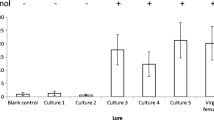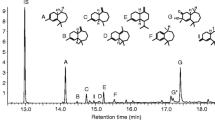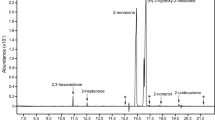Abstract
Dendroctonus ponderosae Hopkins andIps paraconfusus Lanier of both sexes produced most of their complement of terpene alcohols at normal to elevated levels in the absence of readily culturable microorganisms. However, there was some evidence that microbial involvement may be required by maleI. paraconfusus to produce ipsenol and ipsdienol at normal levels. Increased levels of certain terpene alcohols found in axenically reared or streptomycin-fed beetles suggest that symbiotic microorganisms may be responsible for breaking down pheromones and other terpene alcohols. There was also evidence for microbial involvement in the production of the antiaggregation pheromone verbenone inD. ponderosae. This compound was not produced in quantifiable levels by axenically reared or streptomycin-fed beetles exposed to α-pinene as vapors or through feeding, but was found in wildD. ponderosae exposed to α-pinene through feeding on bolts of lodgepole pine,Pinus contorta var.latifolia Engelmann.
Similar content being viewed by others
References
Andryszak, N. A., Payne, T.L., Billings, P.M., andBenenati, J.M. 1982. Effect of flight activity on laboratory response of the southern pine beetle to an attractant.J. Ga. Entomol. Soc. 17:456–460.
Atkins, M.D. 1966. Laboratory studies on the behavior of the Douglas-fir beetle,Dendroctonus pseudotsugae Hopkins.Can. Entomol. 98:953–991.
Atkins, M.D. 1969. Lipid loss with flight in the Douglas-fir beetle.Can. Entomol. 101:164–165.
Barras, S.J. 1973. Reduction of progeny and development in the southern pine beetle following removal of symbiotic fungi.Can. Entomol. 105:1295–1299.
Bedard, W.D. 1966. A ground phloem medium for rearing immature bark beetles (Scolytidae).Ann. Entomol. Soc. Am. 59:931–938.
Bennett, R.B., andBorden, J.H. 1971. Flight arrestment of tetheredDendroctonus pseudotsugae andTrypodendron lineatum (Coleoptera: Scolytidae) in response to olfactory stimuli.Ann. Entomol. Soc. Am. 64:1273–1286.
Bhattacharyya, P.K., Prema, B.R., Kulkarni, B.D., andPradhan, S.K. 1960. Microbiological transformation of terpenes: Hydroxylation of α-pinene.Nature 187:689–690.
Billings, R.F., Gara, R.I., andHrutfiord, B.F. 1976. Influence of ponderosa pine resin volatiles on the response ofDendroctonus ponderosae to synthetic frans-verbenol.Environ. Entomol. 5:171–179.
Borden, J.H. 1967. Factors influencing the response ofIps confusus (Coleoptera: Scolytidae) to male attractant.Can. Entomol. 99:1165–1193.
Borden, J.H., Conn, J.E., Friskie, L.M., Scott, B.E., Chong, L.J., Pierce, H.D., Jr., andOehlschlager, A.C. 1983. Semiochemicals forthe mountain pine beetle,Dendroctonus ponderosae (Coleoptera: Scolytidae), in British Columbia: Baited-tree studies.Can. J. For. Res. 13:325–333.
Borden, J.H., Ryker, L.C., Chong, L.J., Pierce, H.D., Jr., Johnston, B.D., andOehlschlager, A.C. 1987. Response of the mountain pine beetleDendroctonus ponderosae Hopkins (Coleoptera: Scolytidae) to five semiochemicals in British Columbia lodgepole pine forests.Can. J. For. Res. 17:118–128.
Brand, J.M., andBarras, S.J. 1977. The major volatile constituents of a basidiomycete associated with the southern pine beetle.Lloydia 40:398–400.
Brand, J.M., Bracke, J.W., Markovetz, A.J., Wood, D.L., andBrowne, L.E. 1975. Production of verbenol pheromone by a bacterium isolated from bark beetles.Nature 254:136–137.
Brand, J.M., Bracke, J.W., Britton, L.N., Markovetz, A.J., andBarras, S.J. 1976. Bark beetle pheromones: Production of verbenone by a mycangial fungus ofDendroctonus frontalis.J. Chem. Ecol. 2:195–199.
Brand, J.M., Schultz, J., Barras, S.J., Edson, L.J., Payne, T.L., andHedden, R.L. 1977. Bark-beetle pheromones. Enhancement ofDendroctonus frontalis (Coleoptera: Scolytidae) aggregation pheromones by yeast metabolites in laboratory bioassays.J. Chem. Ecol. 3:657–666.
Brattsten, L.B. 1979. Biochemical defense mechanisms in herbivores against plant allelochemicals, pp. 199–270,in G.A. Rosenthal and D.H. Janzen (eds.). Herbivores: Their Interactions with Secondary Plant Metabolites. Academic Press, New York.
Bridges, J.R. 1982. Effects of juvenile hormone on pheromone synthesis inDendroctonus frontalis.Environ. Entomol. 11:417–420.
Buchner, P. 1965. Endosymbiosis of Animals with Plant Microorganisms. Interscience Publishers, New York.
Byers, J.A. 1981. Pheromone biosynthesis in the bark beetle,Ips paraconfusus, during feeding or exposure to vapors of host plant precursors.Insect Biochem. 11:563–569.
Byers, J.A. 1982. Male-specific conversion of the host plant compound, myrcene, to the pheromone, (+)-ipsdienol, in the bark beetle,Dendroctonus brevicomis.J. Chem. Ecol. 8:363–371.
Byers, J.A. 1983. Influence of sex, maturity and host substances on pheromones in the guts of the bark beetles,Ips paraconfusus andDendroctonus brevicomis.J. Insect Physiol. 29:5–13.
Byers, J.A., andWood, D.L. 1981. Antibiotic-induced inhibition of pheromone synthesis in a bark beetle.Science 213:763–764.
Byers, J.A., Wood, D.L., Browne, L.E., Fish, R.H., Piatek, B., andHendry, L.B. 1979. Relationship between a host plant compound, myrcene and pheromone production in the bark beetle,Ips paraconfusus.J. Insect Physiol. 25:477–482.
Chararas, C. 1980. Physiologie des invertébrés—attraction primaire et secondaire chez trois espèces de Scolytidae (Ips) et mécanisme de colonisation.C.R. Acad. Sci. Paris, Ser. D 290:375–378.
Chararas, C., Rivière, J., Ducauze, C., Rutledge, D., Delpui, G., andCazelles, M.-T. 1980. Physiologie des invertébrés—bioconversion d'un composé terpénique sous l'action d'une bactérie du tube digestif dePhloeosinus armatus (Coléoptère, Scolytidae).C.R. Acad. Sci. Paris, Ser. D 291:299–302.
Choudhury, J.H., andKennedy, J.S. 1980. Light versus pheromone-bearing wind in the control of flight direction by bark beetles,Scolytus multistriatus.Physiol. Entomol. 5:207–214.
Cobb, F.W., Jr., Krstic, M., Zavarin, E., andBarber, H.W., Jr. 1968. Inhibitory effects of volatile oleoresin components onFomes annosus and fourCeratocystis species.Phytopathology 58:1327–1335.
Conn, J.E. 1981. Pheromone production and control mechanisms inDendroctonus ponderosae Hopkins. MSc thesis. Simon Fraser University, Burnaby, British Columbia.
Conn, J.E., Borden, J.H., Scott, B.E., Friskie, L.M., Pierce, H.D., Jr., andOehlschlager, A.C. 1983. Semiochemicals for the mountain pine beetle,Dendroctonus ponderosae (Coleoptera: Scolytidae) in British Columbia: Field trapping studies.Can. J. For. Res. 13:320–324.
Conn, J.E., Borden, J.H., Hunt, D.W.A., Holman, J., Whitney, H.S., Spanier, O.J., Pierce, H.D., Jr., andOehlschlager, A.C. 1984. Pheromone production by axenically rearedDendroctonus ponderosae andIps paraconfusus (Coleoptera: Scolytidae).J. Chem. Ecol. 10:281–290.
Conover, W.J. 1980. Practical Nonparametric Statistics. John Wiley and Sons, Toronto.
Coyne, J.F., andLott, L.H. 1976. Toxicity of substances in pine oleoresin to southern pine beetle.J. Ga, Entomol. Soc. 11:301–305.
DeGroot, R.C. 1972. Growth of wood-inhabiting fungi in saturated atmospheres of monoterpenoids.Mycologia 64:863–870.
Fish, R.H., Browne, L.E., Wood, D.L., andHendry, L.B. 1979. Pheromone biosynthetic pathways: Conversion of deuterium labelled ipsdienol with sexual and enantioselectivity inIps paraconfusus Lanier.Tetrahedron Lett. 17:1465–1468.
Fonken, G.S., andJohnson, R.A. 1972. Chemical Oxidations with Microorganisms. Marcel Dekker, New York.
Graham, K. 1959. Release by flight exercise of a chemotropic response from photopositive domination in a scolytid beetle.Nature 184:283–284.
Graham, K. 1962. Photic behavior in the ecology of the ambrosia beetleTrypodendron lineatum.Proc. 11th Int. Congr. Entomol. 2:226.
Greenberg, B. 1970. Sterilizing procedures and agents, antibiotics and inhibitors in mass rearing of insects.Bull. Entomol. Soc. Am. 16:31–36.
Gries, Von G. 1984. Zur frage der dispersion des buchdruckers (Ips typographus L.).Z. Angew. Entomol. 99:12–20.
Gueldner, R.C., Sikorowski, P.P., andWyatt, J.M. 1977. Bacterial load and pheromone production in the boll weevil,Anthonomus grandis.J. Invertebr. Pathol. 29:397–398.
Harring, C. 1978. Aggregation pheromones of the European fir engraver beetlesPityokteines curvidens, P. spinidens, andP. vorontzovi and the role of juvenile hormone in pheromone biosynthesis.Z. Angew. Entomol. 85:281–317.
Hendry, L.B., Piatek, B., Browne, L.E., Wood, D.L., Byers, J.A., Fish, R.H., andHicks, R.A. 1980.In vivo conversion of a labelled host plant chemical to pheromones of the bark beetleIps paraconfusus.Nature 284:485.
Hoyt, C.P., Osborne, G.O., andMulcock, A.P. 1971. Production of an insect sex attractant by symbiotic bacteria.Nature 230:472–473.
Hughes, P.R. 1973.Dendroctonus: Production of pheromones and related compounds in response to host monoterpenes.Z. Angew. Entomol. 73:294–312.
Hughes, P.R. 1974. Myrcene: A precursor of pheromones inIps beetles.J. Insect Physiol. 20:1271–1275.
Hughes, P.R. 1975. Pheromones ofDendroctonus: Origin of α-pinene oxidation products present in emergent adults.J. Insect Physiol. 21:687–691.
Hughes, P.R., andRenwick, J.A.A. 1977. Neural and hormonal control of pheromone biosynthesis in the bark beetle,Ips paraconfusus.Physiol. Entomol. 2:117–123.
Hunt, D.W.A., andBorden, J.H. 1988. Response of mountain pine beetle,Dendroctonus ponderosae Hopkins, and pine engraver,Ips pint (Say), to ipsdienol in southwestern British Columbia.J. Chem. Ecol. 14:277–293.
Hunt, D.W.A., andBorden, J.H. 1989. The role of symbiotic yeasts in verbenone production inDendroctonus ponderosae (Coleoptera: Scolytidae). In preparation.
Hunt, D.W.A., andSmirle, M.J. 1988. Partial inhibition of pheromone production inDendroctonus ponderosae (Coleoptera: Scolytidae) by polysubstrate monooxygenase inhibitors.J. Chem. Ecol. 14:529–536.
Keislich, K. 1976. Microbial Transformations of Non-steroid Cyclic Compounds. J. Wiley & Sons, New York.
Lamer, G.N., andWood, D.L. 1968. Controlled mating, karyology, morphology and sex-ratio in theDendroctonus ponderosae complex.Ann. Entomol. Soc. Am. 61:517–526.
Leufvén, A., Bergström, G., andFalsen, E. 1984. Interconversion of verbenols and verbenone by identified yeasts isolated from the spruce bark beetleIps typographus.J. Chem. Ecol. 10:1349–1361.
Libbey, L.M., Ryker, L.C., andYandell, K.L. 1985. Laboratory and field studies of volatiles released byDendroctonus ponderosae Hopkins (Coleoptera, Scolytidae).Z. Angew. Entomol. 100:381–392.
Pitman, G.B. 1971.trans-Verbenol and α-pinene: Their utility in manipulation of the mountain pine beetle.J. Econ. Entomol. 64:426–430.
Pitman, G.B., Kliefoth, R.A., andVite, J.P. 1965. Studies on the pheromone ofIps confusus (LeConte). II. Further observations on the site of production.Contrib. Boyce Thompson Inst. 23:13–18.
Pitman, G.B., Stock, M.W., andMcKnight, R.C. 1978. Pheromone application in mountain pine beetle-lodgepole pine management: theory and practice, pp. 165–173,in A.A. Berryman, G.D. Amman, and R.W. Stark (eds.). Theory and Practice of Mountain Pine Beetle Management in Lodgepole Pine Forests. University of Idaho, Moscow, Idaho, and USDA, Forest Service, Washington, D.C.
Prema, B.R., andBhattacharyya, P.K. 1962. Microbial transformations of terpenes II. Transformations of α-pinene.Appl. Microbiol. 10:524–528.
Raffa, K.F., andBerryman, A.A. 1983. Physiological aspects of lodgepole pine wound responses to a fungal symbiont of the mountain pine beetle.Can. Entomol. 115:723–734.
Raffa, K.F., Berryman, A.A., Simasko, J., Teal, W., andWong, B.L. 1985. Effects of grand fir monoterpenes on the fir engraver,Scolytus ventralis (Coleoptera: Scolytidae), and its symbiotic fungus.Environ. Entomol. 14:552–556.
Reid, R.W., andGates, H. 1970. Effects of temperature and resin on hatch of eggs of the mountain pine beetleDendroctonus ponderosae.Can. Entomol. 102:617–622.
Renwick, J.A.A., Hughes, P.R., andTy, T.D. 1973. Oxidation products of pinene in the bark beetle,Dendroctonus frontalis.J. Insect Physiol 19:1735–1740.
Renwick, J.A.A., Hughes, P.R., andKrull, I.S. 1976. Selective production ofcis- andtrans-verbenol from (−) and (+) α-pinene by a bark beetle.Science 191:199–201.
Rodriguez, J.G. 1966. Axenic arthropoda: Current status of research and future possibilities.N. Y. Acad. Sci. Ann. 139:53–64.
Rudinsky, J.A., Morgan, M.E., Libbey, L.M., andPutnam, T.B. 1974. Anti-aggregative rivalry pheromone of the mountain pine beetle and a new arrestant of the southern pine beetle.Environ. Entomol. 3:90–98.
Ryker, L.C., andLibbey, L.M. 1982. Frontalin in the male mountain pine beetle.J. Chem. Ecol. 8:1399–1409.
Ryker, L.C., andRudinsky, J.A. 1982. Field bioassay ofexo- andendo-brevicomin withDendroctonus ponderosae in lodgepole pine.J. Chem. Ecol. 8:701–707.
Ryker, L.C., andYandell, K.L. 1983. Effect of verbenone on aggregation ofDendroctonus ponderosae Hopkins (Coleoptera, Scolytidae) to synthetic attractant.Z. Angew. Entomol. 96:452–459.
Sanders, Von W. 1983. Untersuchungen über das verhalten des kupferstechersPityogenes chalcographus L. während der flugphase.Z. Angew. Entomol. 96:125–131.
Shrimpton, D.M., andWhitney, H.S. 1968. Inhibition of growth of blue stain fungi by wood extractives.Can. J. Bot. 46:757–761.
Shukla, O.P., Moholay, M.N., andBhattacharyya, P.K. 1968. Microbiological transformations of terpenes: Part X — Fermentation of α and β-pinenes by a soil pseudomonad (PL-strain).Indian J. Biochem. 5:79–91.
Smith, R.H. 1965. Effect of monoterpene vapors on the western pine beetles.J. Econ. Entomol. 58:509–510.
Sokal, R.R., andRohlf, F.J. 1981. Biometry. W.H. Freeman, San Francisco.
SPSS User's Guide. 1983. McGraw-Hill, New York.
Struble, G.R., andHall, R.C. 1955. The California five-spined engraver: Its biology and control. Circular No. 964. USDA, Washington, D.C.
Sturgeon, K.B., andRobertson, J. 1985. Microsomal polysubstrate monooxygenase activity in western and mountain pine beetles (Coleoptera: Scolytidae).Ann. Entomol. Soc. Am. 78:1–4.
Vanderwel, D., andOehlschlager, A.C. 1987. Biosynthesis and endocrine regulation of pheromone production in Coleoptera, pp. 175–215,in G.D. Prestwich and G. Blomquist (eds.). Pheromone Biochemistry. Academic Press, New York.
Vanderzant, E.S. 1974. Development, significance, and application of artificial diets for insects.Annu. Rev. Entomol. 19:139–160.
Vité, J.P., andGara, R.I. 1962. Volatile attractants from ponderosa pine attacked by bark beetles (Coleoptera: Scolytidae).Contrib. Boyce Thompson Inst. 21:251–254.
Vité, J.P., Bakke, A., andRenwick, J.A.A. 1972. Pheromones inIps (Coleoptera: Scolytidae): Occurrence and production.Can. Entomol. 104:1967–1975.
Whitney, H.S. 1971. Association ofDendroctonus ponderosae (Coleoptera: Scolytidae) with blue stain fungi and yeasts during brood development in lodgepole pine.Can. Entomol. 103:1495–1503.
Whitney, H.S., andSpanier, O.J. 1982. An improved method for rearing axenic mountain pine beetles,Dendroctonus ponderosae (Coleoptera: Scolytidae).Can. Entomol. 114:1095–1100.
Wood, D.L., andVité, J.P. 1961. Studies on the host selection behavior ofIps confusus (Le Conte) (Coleoptera: Scolytidae) attackingPinus ponderosa.Contrib. Boyce Thompson Inst. 21:79–95.
Wood, D.L., Browne, L.E., Bedard, W.D., Tilden, P.E., Silverstein, R.M., andRodin, J.O. 1968. Response ofIps confusus to synthetic sex pheromones in nature.Science 159:1373–1374.
Wood, S.L. 1982. The bark and ambrosia beetles of North and Central America (Coleoptera: Scolytidae), a taxonomic monograph.Great Basin Nat. Memoirs No. 6.
Zethner-Moller, O., andRudinsky, J.A. 1967. Studies on the site of sex pheromone production inDendroctonus pseudotsugae (Coleoptera: Scolytidae).Ann. Entomol. Soc. Am. 60:575–582.
Author information
Authors and Affiliations
Additional information
Research supported in part by Natural Sciences and Engineering Research Council, Canada. Operating Grant A3881, Strategic Grant G1039, and the Science Council of British Columbia Grant 1(RC-10).
Rights and permissions
About this article
Cite this article
Hunt, D.W.A., Borden, J.H. Terpene alcohol pheromone production byDendroctonus ponderosae andIps paraconfusus (Coleoptera: Scolytidae) in the absence of readily culturable microorganisms. J Chem Ecol 15, 1433–1463 (1989). https://doi.org/10.1007/BF01012375
Received:
Accepted:
Issue Date:
DOI: https://doi.org/10.1007/BF01012375




